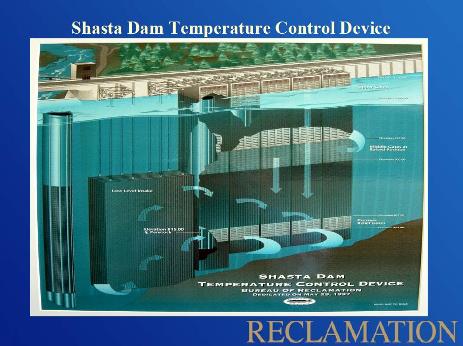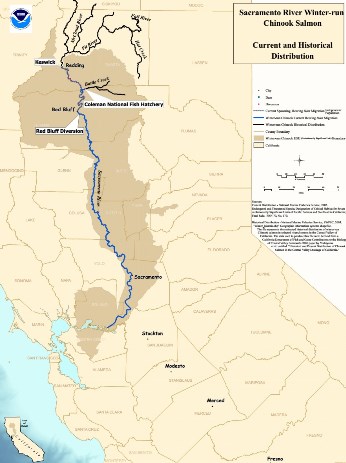Oncorhynchus tshawytscha
Overview
The National Marine Fisheries Service (NMFS) recognizes five Evolutionarily Significant Units (ESUs) of Chinook Salmon in California based on genetic and life history similarities among geographically distinct and adjacent populations: Southern Oregon and California Coastal ESU, Upper Klamath and Trinity Rivers ESU, Central Valley fall-run ESU, Central Valley spring-run ESU, and Sacramento River (SR) winter-run ESU (Moyle 2002).
The SR winter-run ESU includes all naturally spawning populations of SR winter-run Chinook Salmon in the Sacramento River and its tributaries, as well as two conservation programs maintained at Livingston-Stone National Fish Hatchery (LSNFH) owned and operated by U.S. Fish and Wildlife Service (USFWS) (NMFS 2014).
Adult SR winter-run Chinook Salmon pass under the Golden Gate Bridge to begin their spawning migration in November and continue upstream from December through early August. SR winter-run Chinook Salmon spawn in the upper mainstem Sacramento River from mid-April through August, peaking in June and July. Since spawning occurs during the warmest time of the year, adult spawners require stream reaches with plentiful cold, clean water that will protect embryos and juveniles from the warm ambient summer conditions (NMFS 2014). SR winter-run Chinook Salmon require water temperatures between 42.5 and 57.5 degrees Fahrenheit (NMFS 2014). Historically, SR winter-run Chinook Salmon spawned in the upper reaches of Sacramento River tributaries, including the McCloud, Pit, and Upper Sacramento Rivers where cold, spring sourced water is plentiful. Access to these cold-water tributaries has been blocked since the construction of Shasta Dam (1938-1945) and Keswick Dam (1941-1950), by the United States Bureau of Reclamation (USBR). These dams limit the range of spawning habitat to the upper Sacramento River between Red Bluff and Keswick Dam.
Juvenile SR winter-run Chinook Salmon fry and smolts emigrate downstream from July through March through the Sacramento River, and reach the Delta from September through June.
After the dams were completed, SR winter-run Chinook Salmon were able to take advantage of cool summer water releases downstream of Keswick Dam, and the population began recovering from the years of dam construction. However, biologists observed a dramatic drop in run sizes from nearly 120,000 adult spawners in 1969 (Moyle 2004) to a low of 186 spawners in 1993 (GrandTab 2017).
 Figure 1: Front view of the TCD intakes (BOR 1997)
Figure 1: Front view of the TCD intakes (BOR 1997)
Threats
Sacramento River Winter-run Chinook Salmon display a unique migration timing and spawn in the middle of the summer. Prior to Shasta and Keswick Dams, adults spawned in the cold-water upper reaches of the McCloud, Pit and Sacramento Rivers. The summer-spawning life-history trait was advantageous to the species, since hatching occurred prior to fall-run Chinook Salmon spawning. Blockage to spawning grounds reduced SR winter-run Chinook Salmon to one population that spawn in the mainstem below Keswick Dam. Here, salmon egg-nests or redds are vulnerable to high water temperatures, air exposure due to lack of flow, and other threats associated with Shasta Dam hydro-power and water supply delivery operations.
 Figure 2: Cross-sectional view of TCD (BOR 1997)
Figure 2: Cross-sectional view of TCD (BOR 1997)
In the early 1990's the United States Bureau of Reclamation was required to build a Temperature Control Device (TCD) to manipulate the temperature of the water released from the Shasta Reservoir (Figures 1 and 2). This is a large structure situated on the inside face of the dam that allows water from different depths to pass through the hydro-power facility. Water is colder at greater depths through a phenomenon called stratification. The purpose of the TCD is to give State and Federal Agencies responsible for the conservation of SR winter-run Chinook Salmon the ability to control the water temperatures on the SR winter-run Chinook Salmon spawning grounds. The temperatures and the area covered by those temperatures are set each year for maximum survival of juvenile SR winter-run Chinook Salmon in the gravel and when newly emerged.
 Figure 3: Current and historical winter-run habitat on the Sacramento River (NOAA 2014)
Figure 3: Current and historical winter-run habitat on the Sacramento River (NOAA 2014)
The amount of this cold water in Shasta Lake is limited however, and due to many factors, can run out. This is one of the greatest threats to naturally spawning SR winter-run Chinook salmon. If the "cold water pool" is not maintained at sufficient levels, there could be (and have been) catastrophic losses. California Department of Fish and Wildlife (CDFW) estimates that in 2014 and 2015 approximately 95% of the juvenile SR winter-run Chinook salmon production was lost when temperatures on the spawning grounds exceeded the goal of 56°F, after the cold-water pool was depleted. Conflicts can arise, especially during drought conditions, when cold water is needed for both water deliveries to various parts of California, in-Delta flows and the needs of SR winter-run Chinook salmon survival. This can be the largest human controlled factor for SR winter-run Chinook Salmon populations on the Sacramento River and in most years, it is maintained in favor of SR winter-run Chinook Salmon survival. In drought years or when lake water levels are low due to human demand, a lack of cold water can harm an entire year class of juvenile SR winter-run Chinook Salmon.
Key threats to the mainstem Sacramento River migratory corridor include:
- Major ecological shifts in the Sacramento-San Joaquin Delta ecosystem
- Loss of riparian and instream habitat affecting juvenile rearing/growth and outmigration
- Loss of floodplain habitat affecting juvenile rearing/growth and outmigration
- Entrainment in agricultural diversions, including the large State and Federal pumping facilities in the Delta
- Disease, often exacerbated by high water temperatures
- Stranding due to Water Project operations and natural events
- Interspecies competition
- Human Mediated High Predation Rates
- Degraded water quality from agricultural and urban runoff
- Climate Change
Conservation and Management
There are multiple efforts to conserve and expand the current SR winter-run Chinook Salmon populations in the Central Valley. As stated above, the management of the cold-water pool is a critical issue for the only remaining population of winter run. The USBR is responsible for coordinating and convening the Sacramento River Temperature Task (SRTTG); an interagency team assembled to discuss options and provide recommendations. USBR and NMFS decide on the final cold-water pool management plan for the water year.
CDFW facilitates the SR winter-run Chinook Salmon Project Work Team (PWT); an assemblage of biologists from CDFW, California Department of Water Resources (CDWR), Metropolitan Water District (MWD), NMFS, USBR, and USFWS. PWTs focus on specific research and monitoring topics and are part of the Interagency Ecological Program (IEP); a science cooperative in the San Francisco Bay-Delta established in 1970. The IEP winter-run PWT meets every other month and supports the establishment of multiple additional populations of SR winter-run Chinook Salmon in the Central Valley. These populations will provide added resiliency to the single existing population, and will also increase the genetic diversity over time. Two options are being explored as locations for additional populations. Both Battle Creek and the McCloud River have suitable cool summer water quality and available habitat suitable for winter-run Chinook Salmon. Both locations present unique challenges and opportunities for conservation.
In 2016, CDFW released the Battle Creek Chinook Salmon Reintroduction Plan. The reintroduction plan includes strategies for recolonization, local adaptation, and the long-term management of reintroduced stocks. As part of this effort, the plan includes an extensive monitoring and evaluation approach. Implementation of this plan is contingent on several factors such as: successful hatchery production, restored habitat capacity at Battle Creek, and the abundance of natural returns. The plan recognizes the reintroduction of a second population in Battle Creek will be a long-term process.
Another winter-run Chinook Salmon population is being explored for the McCloud River above Shasta Dam. The McCloud River was one of the historical spawning areas for winter-run Chinook Salmon prior to the construction of Shasta Dam. The McCloud River is spring- fed with abundant natural cold water flows. A population in the McCloud River would require a "Trap and Haul" operation for both adults and juvenile fish to pass upstream and downstream of both Shasta and Keswick Dams. The Shasta Dam Fish Passage Evaluation is being developed with USBR, NMFS, USFWS, U.S. Forest Service, CDWR, CDFW and, California State Water Board.
In March of 2018 an experimental reintroduction of winter-run Chinook Salmon was begun in Battle Creek. Approximately 200,000 juvenile salmon were released into Battle Creek. This "jumpstart" of the reintroduction of winter-run into Battle Creek was comprised of the fish from the Captive Brood Stock progeny from LSNFH. This was achieved through a joint effort of CDFW, USFWS and NMFS all working together to achieve this historic milestone.
Species Status
On May 16, 1989, the California Fish and Game Commission listed the SR winter-run Chinook Salmon as endangered under the California Endangered Species Act (CESA). Sacramento River winter-run Chinook Salmon ESU was listed as threatened under the Federal Endangered Species Act on August 4, 1989 and this was subsequently updated to endangered on January 4, 1994. Despite these protections and actions to promote recovery, SR winter-run Chinook Salmon continues to be greatly imperiled.
References
- Moyle P.B. 2002. Inland Fishes of California, University of California Press.
- National Marine Fisheries Service (NMFS). 2014. Recovery Plan for Evolutionarily Significant Units of Sacramento River Winter-run Chinook Salmon and Central Valley Spring-run Chinook Salmon and the Distinct population Segment of California Central Valley Steelhead. California Central Valley Area Office, July 2014.
Prepared by: Daniel Kratville and Mary Olswang
Last updated: April 10, 2018